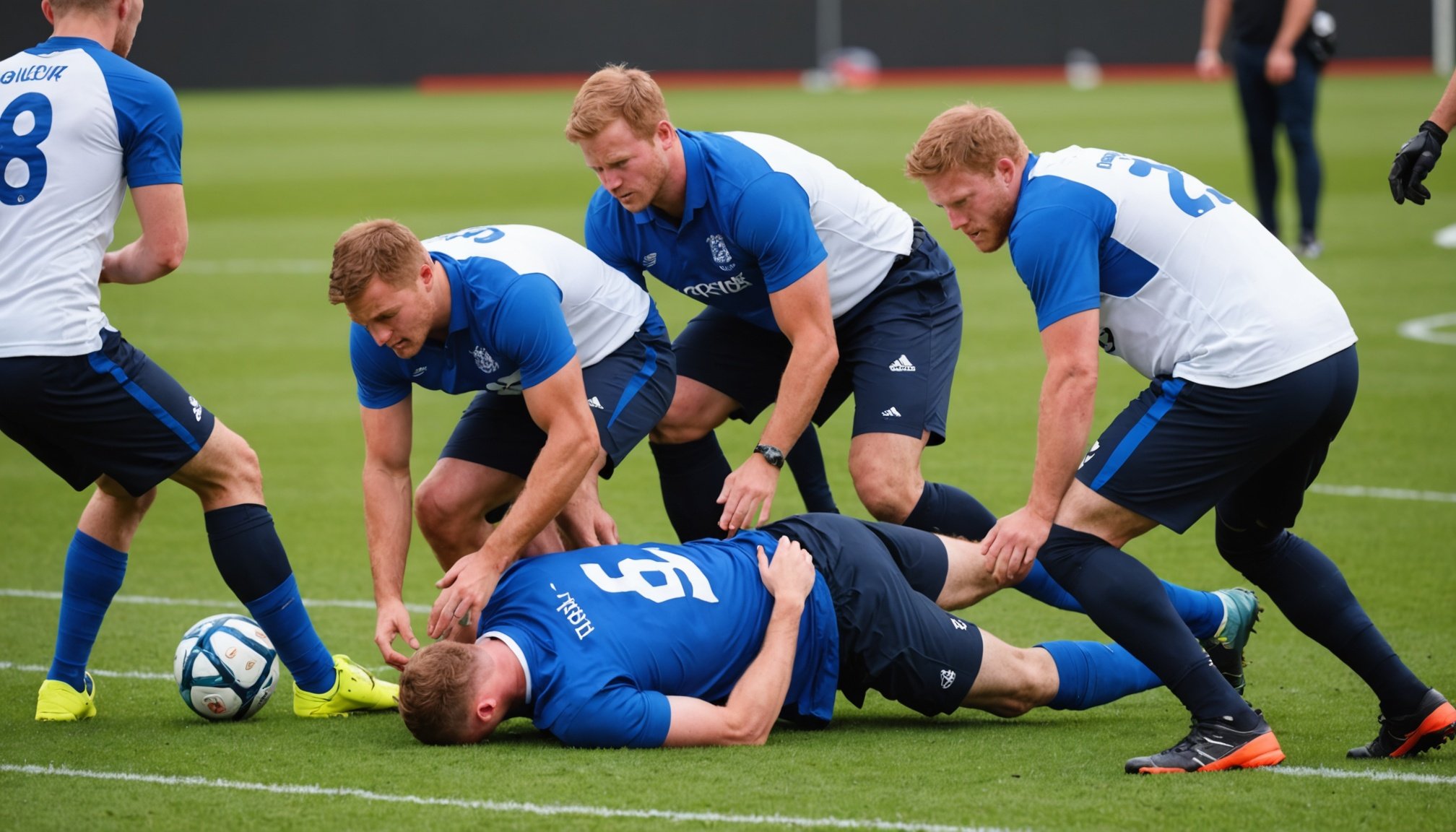Overview of Injury Prevention in UK Football
In the realm of UK football, injury prevention holds paramount importance. It significantly enhances player performance, reducing time spent on recovery. When players remain unscathed, they maintain optimal physical conditions, contributing to teams’ consistent success.
Common injuries in UK football span from muscle strains and ligament tears to concussions. Muscle injuries, particularly strains, affect performance drastically, sidelining players for extensive periods. Ligament injuries, such as ACL tears, also pose threats, often requiring lengthy rehabilitation processes. Concussions, though not as frequent, demand immediate attention due to their serious implications on long-term health.
Also to read : Essential techniques for uk lacrosse coaches to enhance goalie reflexes with impact
The crucial role of coaches and medical staff in mitigating injuries cannot be understated. Coaches strategically plan training sessions, emphasizing exercises that strengthen injury-prone areas. By balancing intensity and rest, they safeguard players from overtraining and undue fatigue, both common precursors to injuries.
Medical staff foster a proactive environment by conducting regular assessments. This includes monitoring players’ health metrics and advising on dietary practices that promote resilience against injuries. By personalizing rehabilitation programs, they expedite recovery, facilitating a swift return to play.
Also read : How can technology be utilized to improve athlete performance in UK sports?
Ultimately, robust injury prevention strategies in UK football not only boost performance but also improve players’ welfare, prolonging careers by avoiding debilitating damage.
Warm-Up Routines
In any athletic performance, incorporating warm-up techniques is essential for injury prevention and enhancing overall effectiveness. Dynamic stretching and mobility exercises rank high as crucial components of a comprehensive warm-up. They prepare the body by increasing blood flow to muscles and improving the range of motion, which reduces the risk of strains and sprains.
Among UK football teams, specific warm-up drills are utilized to ensure athletes are at peak readiness. Drills often include a sequence starting with low-intensity dynamic stretches, progressing to exercises that mimic movements specific to football. These might involve leg swings, walking lunges, or gentle jogging that gradually increase in intensity.
Research underscores the significance of a structured warm-up routine, with studies showing that such practices not only lower injury rates but also boost performance. Effective practices consist of individualized plans that cater to the athlete’s sport and particular needs. Notably, the incorporation of sport-specific movements into warm-ups has been shown to enhance coordination and agility.
A well-structured routine doesn’t just protect from injury but also sets a solid foundation for athletic success. Staying consistent with these practices is paramount for athletes striving for peak performance.
Strength Training Strategies
In the field of football, strength training emerges as a critical component in enhancing physical performance while contributing significantly to injury prevention. This training involves a range of exercises meticulously designed to bolster the muscular capabilities essential for athletes.
Key strength training exercises tailored for football players focus on building core, leg, and upper body strength, crucial in developing agility and power on the field. Examples of these exercises include squats, deadlifts, and bench presses. Each movement targets specific muscle groups, providing a holistic approach to physical conditioning.
The impact of strength on injury risk reduction cannot be overstated. Proper strength training acts as a preventive measure, decreasing the likelihood of acute injuries such as sprains and strains. Stronger muscles enhance joint stability, allowing players to withstand the physical demands of high-intensity matches.
In the UK, several football clubs have embraced successful strength training programs. For instance, they incorporate advanced training methodologies and sports science to tailor regimes that best suit their athletes’ needs. These programs typically include a blend of resistance training, plyometrics, and functional exercises designed to improve overall performance and resilience.
Implementing these strategies not only boosts competitive edge but also ensures long-term athlete health.
Monitoring Player Fatigue
Efficient monitoring techniques are essential in assessing player fatigue and safeguarding athletes against potential injuries. Fatigue not only affects performance but also heightens the risk of injury, making it imperative to track and manage effectively.
Tracking Tools and Methods
Several tools have been developed to monitor fatigue levels accurately. Wearable technology, such as GPS trackers and heart rate monitors, provide continuous data on players’ physical output and recovery. Coupled with software analytics, these tools offer insights into fatigue patterns. Additionally, subjective methods, like surveys and self-reports, allow players to express how they feel physically, adding a qualitative aspect to the monitoring techniques.
The Fatigue-Injury Connection
The connection between fatigue and injury rates is well-documented. Fatigue can lead to improper technique execution, slower reaction times, and decreased cognitive function, increasing the risk of injury during play. Hence, monitoring can act as a predictive measure, identifying athletes who might be at risk and adjusting workloads accordingly.
Case Studies from UK Teams
Several UK teams have implemented successful fatigue management strategies. For instance, they have integrated advanced monitoring techniques, allowing them to personalise training and recovery plans. This approach not only optimises performance but also contributes significantly to injury prevention, demonstrating the practical benefits of fatigue management in sports.
Recovery Protocols
Recovery techniques and injury prevention go hand in hand, especially in competitive sports settings like UK football. Empowering players with the knowledge and tools to recover efficiently can significantly reduce the probability of injury, contributing to longer athletic careers.
Recovery techniques are diverse and can include a combination of rest, active recovery, stretching, and therapies such as physiotherapy or cryotherapy. UK football teams often integrate these methods based on player-specific needs, which provides a personalised touch to how recovery is approached. Notably, sleep quality has been frequently underlined for its regenerative capabilities.
Scientific evidence supports the use of these methods, showing how they can effectively aid in muscle repair and alleviate soreness, which are crucial components of injury prevention.
Furthermore, diet and hydration play pivotal roles in the recovery process. Proper nutritional plans rich in proteins and carbohydrates, supplemented by adequate hydration routines, can expedite muscle recovery and overall performance restoration. The belief here is that what players consume impacts their body’s ability to recover effectively.
Incorporating these evidence-based practices encourages a holistic approach to injury prevention through recovery, aligning with best practices adhered to by top-tier football teams in the UK.
Age-Specific and Gender-Specific Considerations
When it comes to age-specific training, understanding the unique injury risks and prevention needs across different age groups is crucial. Young athletes, for instance, are more prone to growth plate injuries, necessitating tailored training and recovery strategies to protect their developing bodies. Conversely, older individuals often face increased risks of joint-related injuries due to wear and tear, requiring exercises that focus on maintaining flexibility and strength.
Gender differences also play a significant role in training and injury prevention. Research shows that female athletes are generally at a higher risk of injuries such as ACL tears. This necessitates gender-specific considerations in both training regimens and recovery strategies. Females might benefit more from particular strengthening exercises to mitigate these risks.
Moreover, insights from research highlight the importance of tailored injury prevention practices. For example, while younger athletes might focus on agility and coordination to prevent falls, older athletes may benefit from balance exercises. Meanwhile, male and female athletes might benefit from different types of strength training to address their specific physiological needs. Injury prevention strategies must adapt to these variances, ensuring that every individual, irrespective of age or gender, can train safely and effectively. Tailoring these aspects not only enhances performance but also significantly minimizes injury risks.
Expert Insights and Case Studies
Engaging with expert opinions provides invaluable insights into sports medicine practices. Interviews with leading professionals emphasize the adoption of evidence-based techniques to enhance player performance and prevent injuries. These experts point out that integrating new technologies and data analysis into training regimens can dramatically improve outcomes. By continuously adapting to cutting-edge practices, teams remain competitive and safeguard athletes’ health.
Case studies from prominent UK football teams illustrate the tangible benefits of these practices. Teams like Manchester City have successfully implemented innovative recovery protocols, reducing injury rates and enhancing player performance. These examples show how data-driven strategies lead to more informed decisions in both training and recovery processes.
While successful models abound, there remain ongoing challenges in injury prevention. Experts argue that despite advances, inconsistencies in protocol application can limit effectiveness. Teams must ensure consistency in applying injury prevention measures across all levels to achieve sustained success. Furthermore, fostering an environment conducive to open communication between medical staff and coaching teams is essential to align priorities.
Overall, these practical examples and case studies reveal not only the successes but also the remaining hurdles in sports medicine. By learning from these expert insights, other teams can refine their strategies to enhance both player safety and team performance.










